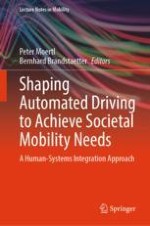
2024 | OriginalPaper | Chapter
Shaping Automated Driving to Meet Societal Mobility Needs: The HADRIAN Project
Authors : Peter Moertl, Bernhard Brandstaetter
Published in: Shaping Automated Driving to Achieve Societal Mobility Needs
Publisher: Springer Nature Switzerland
Activate our intelligent search to find suitable subject content or patents.
Select sections of text to find matching patents with Artificial Intelligence. powered by
Select sections of text to find additional relevant content using AI-assisted search. powered by